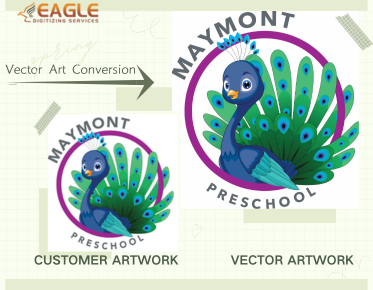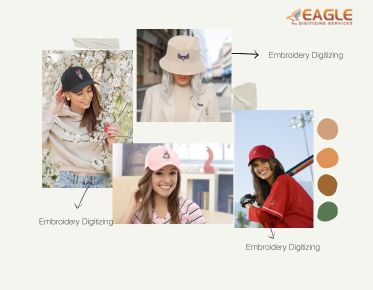Add, Edit, Style: Best Practices for Text in Vector Graphics
Text plays a pivotal role in vector graphics, serving as a bridge between visuals and communication. It's not just about conveying information; it's about evoking emotions, establishing brand identity, and guiding the viewer's journey through the design. Whether it’s a catchy slogan or a detailed explanation, the typography you choose can significantly impact how your audience perceives and engages with your work. For the excellent online vector conversion, have no qualms about getting in touch with us.
Choosing the Right Typeface
Exploring Different Font Families
When it comes to typography, the world of typefaces is an expansive landscape. From the classic elegance of serif fonts to the clean lines of sans-serif, and the playful nature of script fonts, each family brings its personality to your design. Consider the mood and message you wish to convey. For instance, a vintage design may benefit from a rustic serif, while a modern tech company might lean toward a sleek sans-serif. Delving into various font families opens doors to creativity, inviting you to explore unique combinations and unexpected pairings.
How to Select Fonts That Match Your Design Aesthetic
Selecting the right font is akin to finding the perfect accessory for an outfit; it can make or break the overall look. Begin by considering your design aesthetic—are you aiming for something minimalist, ornate, or whimsical? Use contrast to your advantage by pairing a bold typeface with a delicate one to create visual intrigue. Moreover, ensure that the chosen font complements other design elements and maintains a coherent theme throughout your work. Test out various combinations to see how they harmonize with your overall design narrative.
Adding Text: Step-by-Step Guide
Setting Up Your Vector Document for Text
Before diving into the exciting world of typography, it’s crucial to set up your vector document correctly. Choose a suitable canvas size that aligns with your intended output, whether it’s for web, print, or social media. Setting the correct color mode (RGB for digital, CMYK for print) is equally important, as it ensures that your text appears vibrant and true to color in its final form. Organizing layers effectively will also streamline the editing process, allowing you to manage text elements with ease.
Tools for Adding Text in Popular Vector Software
Most vector software, such as Adobe Illustrator or CorelDRAW, provides intuitive tools for adding text. Use the Type tool to create text boxes and enter your content seamlessly. Experiment with different settings, such as character spacing, line height, and kerning, to find the perfect balance that enhances readability and visual appeal. Each program has unique features that can elevate your text, so explore their capabilities to unlock your creative potential.
Text Formatting Fundamentals
Understanding Font Styles: Bold, Italic, and Beyond
Font styles are not merely decorative—they wield the power to convey emphasis and hierarchy within your text. Bold styles command attention, while italics add a touch of elegance or nuance. Don’t hesitate to explore other styles such as underline, strikethrough, or even all caps to add variety and keep your typography dynamic. However, moderation is key; overusing styles can create a cluttered appearance, detracting from the intended message.
Using Size and Spacing to Enhance Readability
Size and spacing are fundamental elements that can drastically influence how your text is perceived. Ensure that your font size is appropriate for the medium; larger sizes work well for headlines, while smaller sizes are suitable for body text. Additionally, adjusting the spacing between characters (tracking) and lines (leading) can significantly enhance readability. Finding the right balance not only improves legibility but also contributes to the overall aesthetic harmony of your design.
Playing with Color
The Psychology of Color in Typography
Color is a potent tool in typography, evoking emotions and influencing perceptions. Understanding color psychology can help you make informed choices when styling your text. For instance, blue often conveys trust and professionalism, while red evokes passion and urgency. Consider your audience and the message you wish to communicate when selecting text colors. Creating a color palette that complements your design will ensure that your typography resonates with viewers.
Best Practices for Choosing Text Colors in Vector Graphics
When choosing colors for your text, prioritize contrast to ensure readability against the background. Dark text on a light background or light text on a dark background creates a striking visual impact. Utilize color combinations that are easy on the eyes, steering clear of clashing hues that can confuse. Tools like Adobe Color can help you generate harmonious color schemes, making the selection process enjoyable and efficient.
Alignment Matters: Positioning Your Text
Aligning Text for Maximum Impact
Alignment can dramatically affect the visual flow of your design. Consider how your text interacts with other elements on the canvas. Centered text exudes a sense of formality, while left-aligned text creates a more casual, approachable feel. Experiment with right alignment or even justified text to achieve the desired effect. The key is to maintain consistency throughout your design to establish a cohesive visual language.
Creating Balance with Text Placement
Strategic text placement can guide the viewer’s eye through your design. Balance is essential; a lopsided composition can create discomfort and distract from the message. Utilize the rule of thirds, placing text at focal points to draw attention where it matters most. Incorporating ample white space around your text can also enhance its presence, allowing it to breathe within the composition.
Editing Text: Making Changes with Ease
How to Edit Text Without Losing Quality
Editing text in vector graphics should feel seamless and effortless. Vector software allows for non-destructive editing, meaning you can adjust text without compromising quality. Use the Type tool to make changes on the fly, ensuring that your edits are smooth and precise. This flexibility enables you to experiment with different styles and configurations, helping you refine your design until it perfectly embodies your vision.
Mastering the Art of Text Modification
Text modification involves more than just changing words; it’s about fine-tuning the appearance and impact of your typography. Adjusting font weight, style, or color can elevate your design, but don’t forget about the power of rephrasing. Craft your messages with intention, ensuring clarity and engagement. The art of modification lies in the details, where subtle tweaks can transform good typography into great typography.
Styling Techniques to Elevate Your Text
Exploring Text Effects: Shadows, Outlines, and More
To add a touch of flair to your text, explore various styling techniques. Shadows can create depth, making your text pop off the page, while outlines can help define and separate your text from busy backgrounds. Experiment with transparency and blending modes to achieve unique effects that enhance your overall design. However, remember that less is often more; using too many effects can clutter your design and distract from the message.
Incorporating Gradients and Patterns into Text
Incorporating gradients and patterns into your text can elevate your design to new heights. Gradients add dimension and visual interest, while patterns can infuse personality and texture. When using these techniques, ensure that they complement your overall design without overwhelming it. Subtlety is key; aim for a harmonious blend that enhances the text rather than overshadowing it.
Using Hierarchy to Guide the Eye
The Power of Headings and Subheadings
Hierarchy is crucial in guiding viewers through your text. Use headings and subheadings to create a structured flow, helping readers navigate your content effortlessly. Different font sizes and weights can signify importance, ensuring that your audience knows where to focus their attention. This visual hierarchy not only enhances readability but also improves comprehension, making your message more impactful.
Creating Visual Flow with Text Hierarchy
Creating visual flow with text hierarchy involves thoughtful arrangement and design choices. Use alignment, spacing, and color contrast to differentiate between various levels of text. This intentional structure allows readers to skim easily while still grasping the key points. By establishing a clear visual hierarchy, you enhance the overall user experience, making your designs not only aesthetically pleasing but also functional.
Combining Text with Other Elements
Integrating Text with Graphics for a Cohesive Look
Combining text with graphics requires a delicate balance, ensuring that both elements work harmoniously. Use shapes, images, and colors to create a cohesive look that enhances your message. For instance, placing text over a solid shape can improve readability while grounding the design. Aim for synergy, where text and graphics complement each other, creating a unified visual experience.
Layering Text Over Images: Tips and Tricks
Layering text over images can create stunning visuals, but it requires careful consideration to ensure readability. Use contrasting colors or semi-transparent backgrounds behind your text to make it stand out against the image. Experiment with blending modes to achieve creative effects, and be mindful of the image's focal points. Position your text where it enhances the composition without distracting from the overall image.
Exporting and Saving Text in Vector Graphics
Choosing the Right File Format for Different Outputs
Choosing the right file format is essential for preserving the quality of your text in vector graphics. Common formats include SVG for web graphics, PDF for print, and EPS for high-quality illustrations. Each format has its unique strengths and use cases, so understanding their differences can help you make informed decisions based on your intended output.
Preserving Text Quality During Export
When exporting your designs, preserving text quality is paramount. Ensure that you select options that maintain vector data, preventing rasterization that can compromise clarity. Additionally, double-check your export settings to ensure they align with your desired output. This attention to detail will guarantee that your typography shines, even in its final form.
Accessibility Considerations
Ensuring Your Text is Readable for All Audiences
Accessibility in design is essential, ensuring that your text is legible for all audiences, including those with visual impairments. Choose fonts that are easy to read and maintain sufficient contrast against backgrounds. Avoid overly stylized fonts that may hinder comprehension and ensure that your text size is appropriate for diverse readers.
Using Contrast and Size for Better Visibility
Contrast and size play critical roles in ensuring visibility. Use high-contrast color combinations to enhance readability and choose font sizes that cater to a wide audience. Consider providing options for resizing text or utilizing tools that allow users to adjust readability settings. These small adjustments can make a significant difference in user experience, promoting inclusivity in your designs.
Testing and Iterating Your Designs
Getting Feedback on Text Elements
An essential component of the design process is feedback. Share your designs with peers or potential users to gain insights into how your text elements resonate. Constructive criticism can unveil hidden issues and spark new ideas, allowing you to refine your typography further.
Making Adjustments Based on Audience Response
Once you gather feedback, be prepared to make adjustments based on audience response. An open-minded approach to critique can lead to breakthroughs in your design, ensuring that your text effectively communicates its intended message. Iteration is key; don’t hesitate to revisit and revise until your typography truly shines.
Typography in vector graphics is an intricate dance of creativity and precision. By adhering to best practices for adding, editing, and styling text, you can create designs that are not only visually captivating but also effective in communication. Embrace the art of typography as an opportunity to explore your creativity, experimenting with fonts, colors, and layouts to craft compelling narratives that resonate with your audience.


